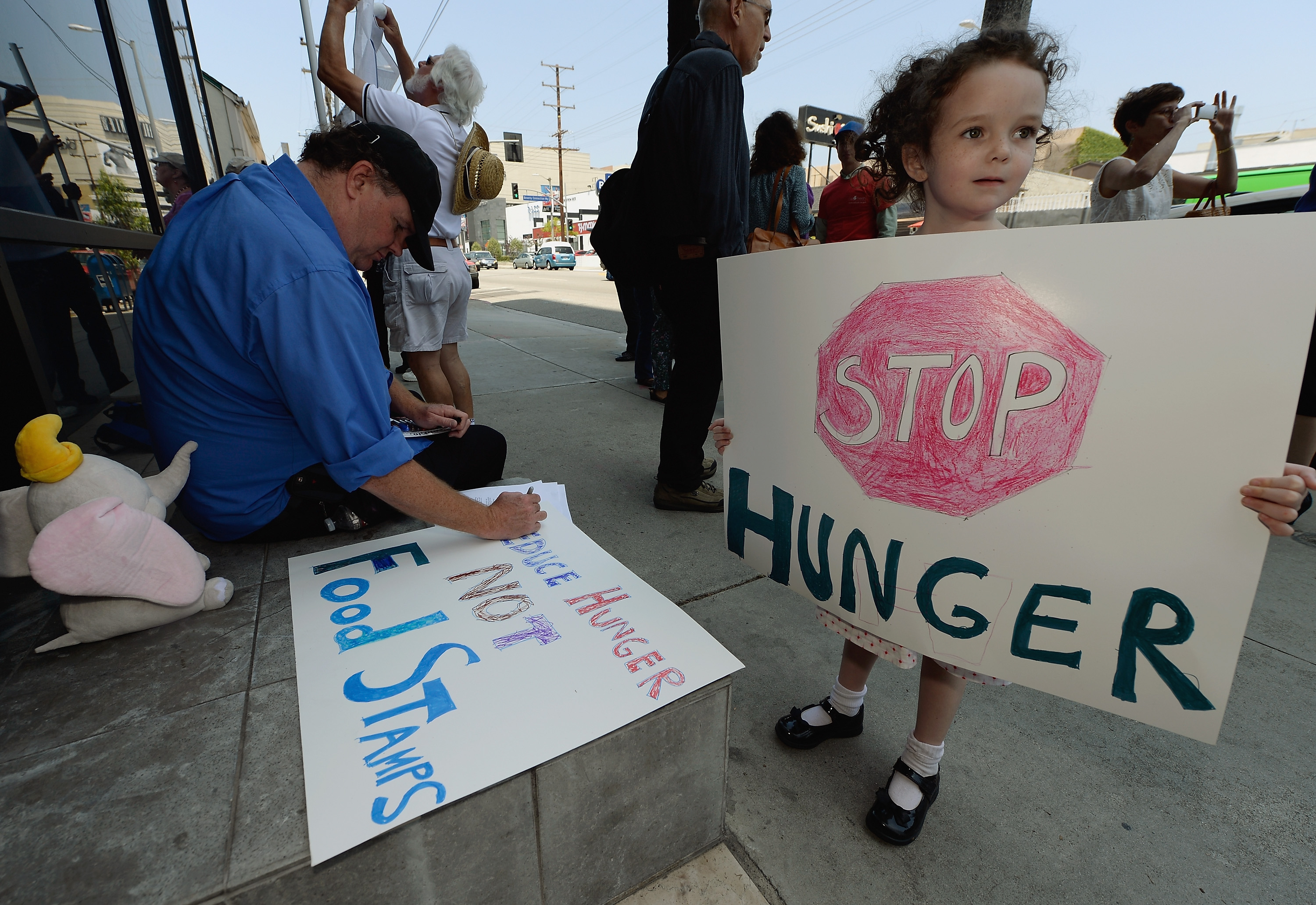How SNAP Cuts Put Millions of Americans at Risk of Hunger

“SNAP, formerly known as food stamps, is the largest anti-hunger program in America.”
On July 4, 2025, President Donald Trump signed congressional Republicans’ One Big Beautiful Bill Act (OBBBA) into law—enacting the largest-ever cuts to basic needs programs in U.S. history.
The law includes severe cuts to the Supplemental Nutrition Assistance Program (SNAP), which benefits roughly 42 million Americans per month in 2024, at a cost of $100 billion.
Its cuts are expected to impact millions of Americans, particularly vulnerable populations, but some of these effects will not be felt for some time.
However, experts and business owners see these widespread cuts as a direct blow to the economic infrastructure that supports many low-income communities, noting that this is the largest cut to SNAP in its 86-year history.
The Trump administration has ordered states to submit SNAP beneficiary data by July 30 or risk losing federal funding to administer the program.
This measure raised concerns that it could be used to persecute immigrants and prompted 20 states to file lawsuits against the government.
SNAP Cuts
Last month, Congress passed a budget law for Trump's second term, including tax cuts and cuts to food assistance programs.
Official estimates warned of a significant increase in the federal deficit and debt, while the White House hailed the move as a victory for President Trump's policies.
While some key provisions of the law will take effect later this year, others will not be implemented until well after the midterm elections.
Among the most controversial provisions of the law are its reforms to the nation's largest food assistance program, which will undergo changes in funding and work requirements.
SNAP, formerly known as food stamps, is the largest federally funded program to combat hunger in America.
It issues electronic benefits that can be used like cash to purchase food.
It is run by the USDA Food and Nutrition Service, which administers federal food assistance programs.
Currently, SNAP benefits average about $188 per month—or roughly $6 per day—so further reducing benefits or increasing barriers to access will force people to go hungry.
Estimates have found that millions enrolled in the SNAP could be affected by more stringent work requirements set by the new law.
The law raises the work requirement age from 54 to 64 and adds parents with children older than 6. Parents with dependent children at home, regardless of age, are currently exempt from these requirements. Those changes will go into effect as early as this year.
The Republican spending law also forces states to shoulder at least 5% of SNAP benefit costs starting in 2028. Currently, the program is 100% federally funded.
The Congressional Budget Office estimated that changes to the work mandate would reduce participation in SNAP by more than three million people in an average month over the next decade.
The left-leaning Center on Budget and Policy Priorities has estimated that more than five million people live in a household that would be at risk of losing at least some food assistance because of the expanded work requirements.
The domestic policy law also cuts off food stamps for some immigrants who are lawfully present in the country and makes it harder for areas to qualify for work requirement waivers if they have higher rates of unemployment.
It also ends work requirement exemptions for veterans, homeless people and certain former foster youth.
The SNAP cuts total an estimated $230 billion over 10 years.

Wider Consequences
By sharply cutting SNAP, Trump’s OBBBA also imperils the program’s role as an economic anchor for grocery stores and communities, particularly in rural areas, according to grocers and economists.
SNAP is a great economic driver for US industry and the supply chain, including farmers, manufacturers and wholesalers.
In May, progressive think tank Center for American Progress identified 27,000 retailers — mostly in rural areas with large shares of SNAP recipients — as likely to shoulder the brunt of cuts.
Food experts say small, independent grocers that depend heavily on SNAP to sustain razor-thin profit margins that will be hit the hardest.
But large chains such as Walmart, Kroger, and Dollar General can absorb the hit.
In 2023, SNAP accounted for $124 billion in sales at 262,000 retailers, half of which were at superstores such as Walmart, while a quarter went to supermarkets.
At Wright’s Market, shoppers using SNAP benefits are a reliable customer base and help guide business decisions.
For example, the store designs its food selection and prices to meet the budgets of low-income customers on assistance.
It also participates in Agriculture Department programs designed to help SNAP recipients buy fresh fruits, vegetables and milk.
But SNAP cuts may force Wright’s Market to raise prices or cut jobs.

The Department of Agriculture stated that every $5 in new SNAP benefits generates as much as $9 of local economic activity.
Food stamps also lead to more stores and higher employment, sales, and salaries, a 2020 study by University of California, Davis, researchers found.
House Republicans say the changes will restore integrity to the program and benefit grocers by pushing more people to work.
Studies have shown that new work requirements for SNAP do not increase employment, while cuts may result in job losses.
A study earlier this year by the nonprofit research group Commonwealth Fund estimated that cuts could result in the loss of 143,000 food-related jobs in agriculture, retail grocery and food processing.
In turn, economist Dr. Mustafa Shaheen, in a statement to Al-Estiklal, argued that “the success of SNAP in the U.S. lies in directing public resources through the private sector.”
He pointed out that “cutting this federal support could push millions of people to food banks, which lack the resources to meet this increased demand.”
“In this scenario, far from stimulating jobs or reducing spending, Trump’s OBBBA could exacerbate food poverty, cause unemployment, and accelerate the collapse of hundreds of communities that rely on SNAP for survival,” he added.
“To prevent drastic increases in hunger for struggling families, Congress must reject proposed cuts to the SNAP,” Dr. Shaheen said.
Earlier in 2025, the Trump administration froze or cut nearly $1 billion in federal funding that food banks rely on to serve their communities, during a period when demand had already hit record levels in many parts of the country.

Critical Support
Republicans claim that SNAP cuts would target waste, fraud, and abuse in the entitlement programs and would save hundreds of billions of dollars over the next decade.
Democrats and food security advocates disagreed, noting that SNAP cuts could cost millions of low-income families crucial food assistance in every state.
In a letter on June 24, Democratic governors from 23 states urged congressional leaders to reject any proposals that would put state SNAP programs at risk.
The governors said the proposed cuts in Trump's megabill would effectively gut the powerful hunger assistance tool utilized by more than 42 million food-insecure Americans who are already facing rising grocery costs.
"SNAP cuts will mean that millions of Americans won't get the food they need for their families," they wrote
20 states have filed a lawsuit against the Trump administration to prevent the USDA from collecting sensitive information about people who receive federal food stamps, known as SNAP.
Attorneys general that are filing the suit argue that the Trump administration’s policy is arbitrary and capricious, violates the 10th Amendment that protects states’ rights, as well as various privacy laws.
The Trump administration has tried to tap several state databases to quickly amass troves of sensitive personal information about hundreds of millions of people.
Using that information is part of Trump’s effort to fulfill his campaign promise of carrying out the largest mass deportation effort in U.S. history.
The Trump administration said that collecting the data is aimed at preventing waste and fraud.
Trump issued an executive order in March that ordered his administration to have unfettered access to comprehensive data from all state programs that receive federal funding.
In May, his administration sought Social Security numbers, addresses and, for one state, citizenship data, for SNAP recipients.

In a letter to Agriculture Secretary Brooke Rollins, 13 Democratic senators slammed a public notice the USDA issued that grants itself broad authority for using SNAP recipients' data.
“This policy would turn a program that feeds millions of Americans into a tool of government mass surveillance,” they wrote.
They called on the agency to reverse course and warned that otherwise, the USDA would be at serious risk of violating federal law.
Sources
- Trump’s megabill may force your local grocery store to close
- How Trump's tax cut and spending megabill would impact SNAP recipients
- Trump wants sensitive data about food stamp recipients. California is suing to block him
- A primer on SNAP work requirements [Study]
- Potential Federal Cuts to SNAP [Study]
- Food-Assistance Programs Have Positive Impacts on Food Retail [Study]










